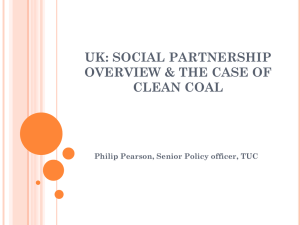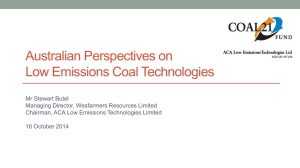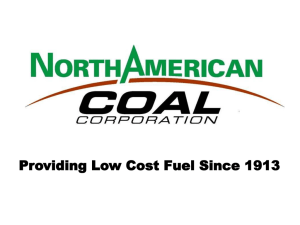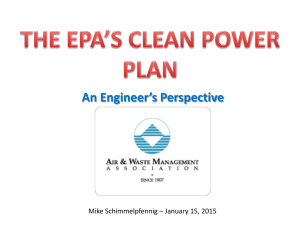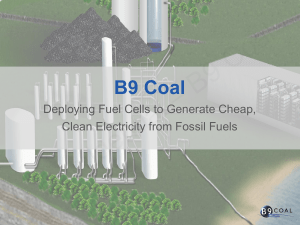Carbon Capture and Storage: What It Is
advertisement
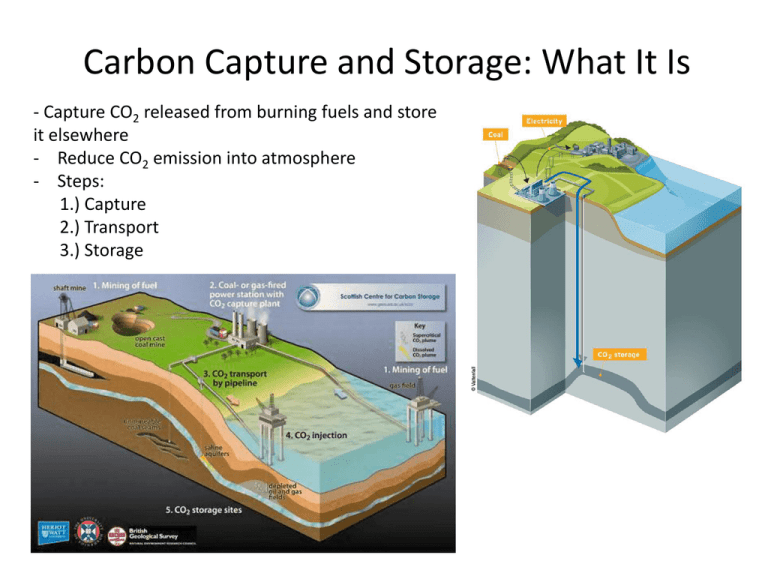
Carbon Capture and Storage: What It Is - Capture CO2 released from burning fuels and store it elsewhere - Reduce CO2 emission into atmosphere - Steps: 1.) Capture 2.) Transport 3.) Storage Carbon Capture and Storage: Capture Methods of Capturing: - Post Combustion Capture - Pre-Combustion Capture - Oxy-fuel Combustion - Oxygen Extracted Air Carbon Capture and Storage: Transportation Methods of Transportation: - Pipelines - COA conveyor belt system - Ships Carbon Capture and Storage: Storage Methods of Storage: - Geological Storage (Oil fields, Unmineable coal seams, Saline aquifers) - Ocean Storage - Mineral Storage Carbon Capture and Storage: What Phase It’s In • 8 large-scale CCS project currently in operation (as of mid2011) • 6 under construction • 75 in progress Hydrocarbon Reservoir Zones: • Algeria: In Salah • Norway: Sleipner • Norway: Snohvit Enhanced Oil Recovery: • Canada/North Dakota: Great Plains Synfuel Plant and Weyburn-Midale Project • US: – – – – Shute Creek Gas Processing Facility. ExxonMobil. Enid Fertilizer Val Verde Natural Gas Plants Century Plant – largest 10 countries currently working on integrating carbon capture into environmental conservation plans: Canada, Italy, Netherlands, Norway, Poland, US, UK, China, Germany, Australia 4 projects in progress that are trying to integrate carbon capture: • American Clean Coal Fuels: coal and biomass to liquids. Each gallon of their fuel used, carbon is pulled out of air and put into ground. Life-cycle carbon negative • Baard Energy: same + market CO2 for EOR • Rentech: market CO2 for EOR • DKRW: coal to liquids for EOR Problems • Funding (marginal cost and benefit, no revenue, etc.) • Efficiency • Even EOR won’t help us escape oil crisis • Just reduces global greenhouse gas emissions Technological Feasibility - Removing the Carbon Dioxide is not the problem, it’s storing it that’s the main issue. Environmentally feasible - CCS only removes the pollutant Carbon Dioxide - Does not mitigate environmental damage caused by coal harvesting. Economic Feasibility 2020, 2030, or 2050? Is it Economical • • • • • • • • Initial estimates: cost of CCS from the atmosphere at under $200 per ton Proceedings of the National Academy of Sciences (PNAS): The atmospheric concentration, however, is over 100 times lower, which shoots the cost up to $2,500/ton. Even adding in various optimistic assumptions doesn’t bring the cost down below $1,000/ton. The good news? Clean coal could become an economically viable alternative source of energy down the road. The bad news? It’s a long road—and the short term isn’t pretty. Capture 90% of their carbon emissions at a cost of between $100 and $150 a ton Add between 8 and 12 cents per kilowatt hour to the cost of coal Once the technology is mature and more efficient plants are up and running, the economics look better: It will cost between $30 and $50 per ton of carbon, or an extra 2 to 5 cents per kilowatt hour Harvard figures that “maturity” means between 50 and 100 gigawatts of clean coal plants in operation The proposed Waxman-Markey climate bill promises $60 billion in subsidies Can it be Used in 100 Years • James Hansen, one of the world’s best-known global warming researchers and a recent vocal advocate of proposed coal plants, says clean coal technology used on a full-scale coal-fired plant could be at least a decade away • Enough potential in energy efficiency and renewable energy to sustain until clean coal issue is solved • Clean coal is NECESSARY because coal plants without carbon capture will not be economically viable in the future • Largest problem with carbon capture is getting coal plants to agree to the idea since most plants are not willing to invest in the carbon capture technology POXC: Pressurized Oxycombustion • Pratt & Whitney Rocketdyne – capture more than 90 percent of produced carbon dioxide with no more than a 35 percent increase in electricity costs – uses pressurized oxygen and recycled carbon dioxide gas to improve process efficiency and eliminates nitrogen from the exhaust IGCC: Integrated Gasification Combined Cycle • Pre-combustion: – Gasified coal is used to run a turbine to produce power. – Waste heat from the process is captured as steam and used to create more power. – CO2 isn't captured. – Hydrogen Energye (BP and Rio Tinto): • CCS plant in California that could burn coal using IGCC to separate the CO2 and capture it Oxyfuel • Combustion process: – Burning coal in a mix of carbon dioxide, water vapor, and pure oxygen – Plant in Germany became the first full-cycle oxyfuel providing power for about 1,000 homes – Waste CO2 is compressed, transported and buried two miles below a depleted gas field. Storage of Waste co2 Underground • CO2 underground: – Forces oil to the surface. – Selling captured CO2 to oil field operators balances some of the investment in CCS Summary • Economic efficiency • Technology – IGCC – Oxyfuel – Underground Storage • Implementation Sources • http://www.greenleft.org.au/node/43403 • http://www.msnbc.msn.com/id/27522321/ns/us_news-environment/t/clean-coal-idea-madeit-campaign-trail/#.UIX-cml27nI • http://www.coal-is-dirty.com/the-coal-hard-facts • http://www.librarygrape.com/2011/12/clean-coal-is-not-here-today-and-wont-be-feasibletomorrow.html • http://blogs.wsj.com/environmentalcapital/2009/07/20/clean-coal-competitive-someday-justnot-today/ • http://gigaom.com/cleantech/james-hansen-clean-coal-tech-could-be-a-decade-away/ • http://www.marketwatch.com/story/pratt-whitney-rocketdyne-receives-1-million-award-fromus-department-of-energy-to-advance-oxy-combustion-technology-2012-10-02 • http://www.factcheck.org/politics/clean_coal_confrontation.html


